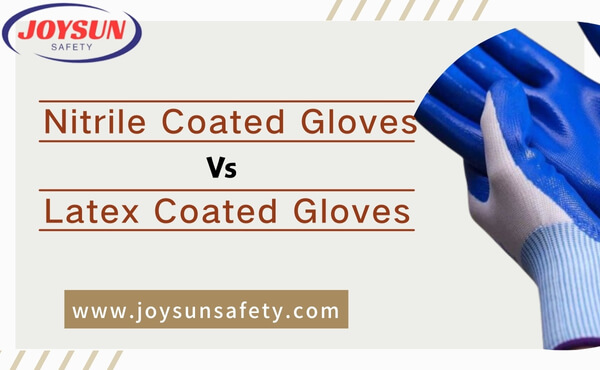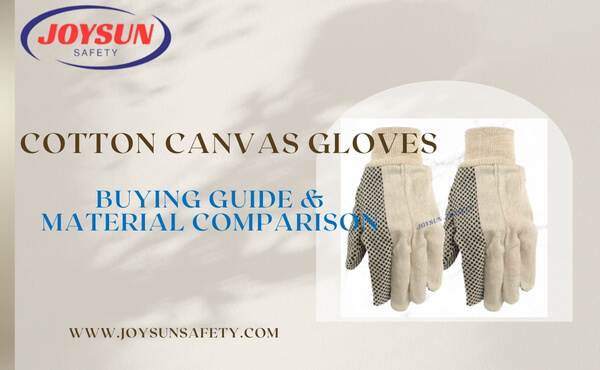When it comes to protecting your hands during various tasks, choosing the right gloves is essential. Among the many options available, cotton canvas gloves stand out for their durability, comfort, and versatility. However, they are not the only choice on the market. Other materials, such as leather, rubber, and synthetic fibers, also offer unique benefits and can be better suited for specific tasks.
Understanding the strengths and weaknesses of each type of glove can help you make an informed decision, ensuring you have the best protection for your needs. In this article, we’ll explore the advantages and disadvantages of cotton canvas gloves compared to other materials, helping you determine which type is best for your specific requirements.
Cotton Canvas Work Gloves
Cotton canvas work gloves, often recognized by their signature cotton fabric weave, offer durability and a snug fit for handling general tasks. The cotton canvas is typically robust, providing increased comfort for extended wear, and these gloves are often designed with features like knit materials around the wrists or double palms for extra protection. They excel in environments where dexterity and a comfortable fit are more essential than advanced protective qualities.
The manufacturing process for cotton canvas work gloves ensures a sturdy build, often with a cut-n-sewn cotton glove design ideal for parts handling or light heat applications. While they may not be cut resistant or suited for foundry operations, their chore gloves variant, which is more heavy-duty, can offer more hand protection for tougher jobs. Yet, for specialized tasks, one may need to look beyond cotton canvas to find the appropriate safety gloves.
Key Features
When it comes to selecting gloves for various tasks, cotton canvas gloves offer several compelling features. Let’s highlight the key features that make these gloves a popular choice:
- Natural cotton fibers: Allow the skin to breathe, reducing hand fatigue during prolonged use.
- Seamless knit design: Ensures a comfortable fit.
- Woven or knit cotton material: Provides flexibility and ease of movement.
- Protective qualities: Suited for general use, keeping hands clean while performing light tasks.
- Snug fit: Often designed for a close fit, with some variants offering string knit construction for enhanced dexterity.
- Soft cotton fabric: Gentle against the skin, providing increased comfort for day-to-day manual work.
- Utility in specific settings: While not as resistant as other glove types, they offer significant utility in many scenarios.
Comparison of Cotton Canvas Gloves Vs. Other Materials
When comparing cotton canvas gloves with other materials, it’s crucial to consider factors such as the level of chemical resistance, tactile sensitivity, and the need for cut-resistant gloves. While cotton canvas offers breathability and comfort, alternatives like nitrile gloves offer superior chemical resistance and are often used in more hazardous environments.
Leather Gloves
Leather gloves, crafted from materials such as cow leather or deer leather, stand out in glove selection for their durability and resistance to sharp objects. The tactile sensitivity of leather providing a secure grip makes them a preferred choice for tasks that require precision. Glove materials like these are also known for keeping hands warm in cold conditions, making them advantageous in outdoor or refrigerated environments.
Best uses
- Heat protection and puncture resistance: Suitable for welding, construction, and handling sharp objects.
- Warmth: Ideal for outdoor work in cooler climates, providing both protection and comfort.
In comparison to cotton canvas gloves, leather gloves offer superior protection and durability but may lack the breathability and comfort of cotton, especially for prolonged use in warmer conditions.
Synthetic Leather Gloves
Synthetic leather gloves, utilizing materials like synthetic leather, pigskin gloves, grain leather, and split leather, offer an alternative to traditional leather gloves. They balance tactile sensitivity with abrasion resistance, tensile strength, and protection against sharp objects. These abrasion-resistant gloves can withstand extreme temperatures and are comfortable to wear, making them a versatile option in glove selection.
Best uses
- Dexterity and heat protection: Ideal for tasks requiring precision and protection, such as automotive work, carpentry, and general maintenance.
- Puncture resistance: Suitable for handling sharp objects, providing a secure grip and enhanced safety.
In comparison to cotton canvas gloves, synthetic leather gloves offer greater durability and protection, especially in demanding environments. However, cotton canvas gloves provide superior breathability and comfort for prolonged use in lighter tasks.
Latex, Rubber or Plastic Gloves
Latex gloves, along with other types like rubber and plastic gloves, offer a different level of heat resistance and protection. Made from materials like butyl rubber, they are impermeable to liquids, providing a sturdy barrier against contamination and hazardous substances. These gloves are essential for tasks that involve exposure to chemicals or biohazards.
Best uses
- Medical settings, cleaning, and chemical handling: Impermeability to fluids and heat resistance make them crucial for safety.
In comparison to cotton canvas gloves, latex, rubber, and plastic gloves provide superior protection against liquids and chemicals but may lack the breathability and comfort needed for prolonged use in general tasks.
Neoprene/Chloroprene Gloves
Neoprene or chloroprene gloves, made from synthetic materials, offer a unique combination of flexibility and chemical resistance. They maintain tactile sensitivity while protecting against sharp objects, and are well-regarded for their durability and ability to withstand a range of temperatures and environmental conditions.
Best uses
- Handling hazardous materials, working with solvents: Ideal in industries where chemical exposure is a risk, providing a secure barrier while allowing for dexterity.
Compared to cotton canvas gloves, neoprene/chloroprene gloves excel in chemical resistance and durability but might not offer the same level of comfort and breathability for lighter, everyday tasks.
PU Gloves
PU gloves, constructed with synthetic materials, are recognized for their lightweight design and tactile sensitivity. They offer a secure grip and are resistant to sharp objects, making them suitable for precision tasks that require a high level of dexterity.
Best uses
- Electronics assembly, painting, fine parts handling: Protect against abrasions while ensuring the user’s hands remain nimble and sensitive to touch.
While PU gloves provide excellent dexterity and precision, cotton canvas gloves are better suited for general use and provide greater comfort for extended wear.
PVC Gloves
PVC gloves are known for their durability and tactile sensitivity, making them a practical choice for handling a variety of materials, including sharp objects. They provide a reasonable level of protection while ensuring that the user retains a good sense of touch.
Best uses
- General material handling: Suitable for tasks involving sharp objects while maintaining tactile sensitivity.
In comparison to cotton canvas gloves, PVC gloves offer more durability and protection but may not be as comfortable for long-term wear.
Nitrile Gloves
Nitrile gloves are made from nitrile rubber, offering excellent resistance to a wide variety of chemicals. As a synthetic material, nitrile is more puncture resistant than most rubber gloves and can provide adequate protection against minor cuts and abrasions. These gloves are available in both reusable and disposable forms, with the latter being particularly useful in medical settings or for handling hazardous materials.
Best uses
- Medical examinations, laboratory work, automotive maintenance, food service: Ideal for tasks requiring contact with oils, greases, chemicals, and hazardous materials.
Compared to cotton canvas gloves, nitrile gloves provide superior chemical resistance and puncture protection but lack the breathability and comfort for general, everyday use.
Wrap-Up!
In conclusion, cotton canvas gloves offer distinct advantages that set them apart in various tasks. Their woven fabric construction provides durability and breathability, reducing hand fatigue during extended use. The seamless knit design ensures a comfortable fit, allowing flexibility and ease of movement essential for manual activities.
Compared to materials like leather, synthetic alternatives, and rubber, cotton canvas gloves prioritize comfort and airflow, making them ideal for general tasks where dexterity and protection from dirt are crucial. While other gloves may excel in specific areas such as durability or chemical resistance, cotton canvas gloves remain a practical choice for everyday use, balancing comfort with adequate protection.















